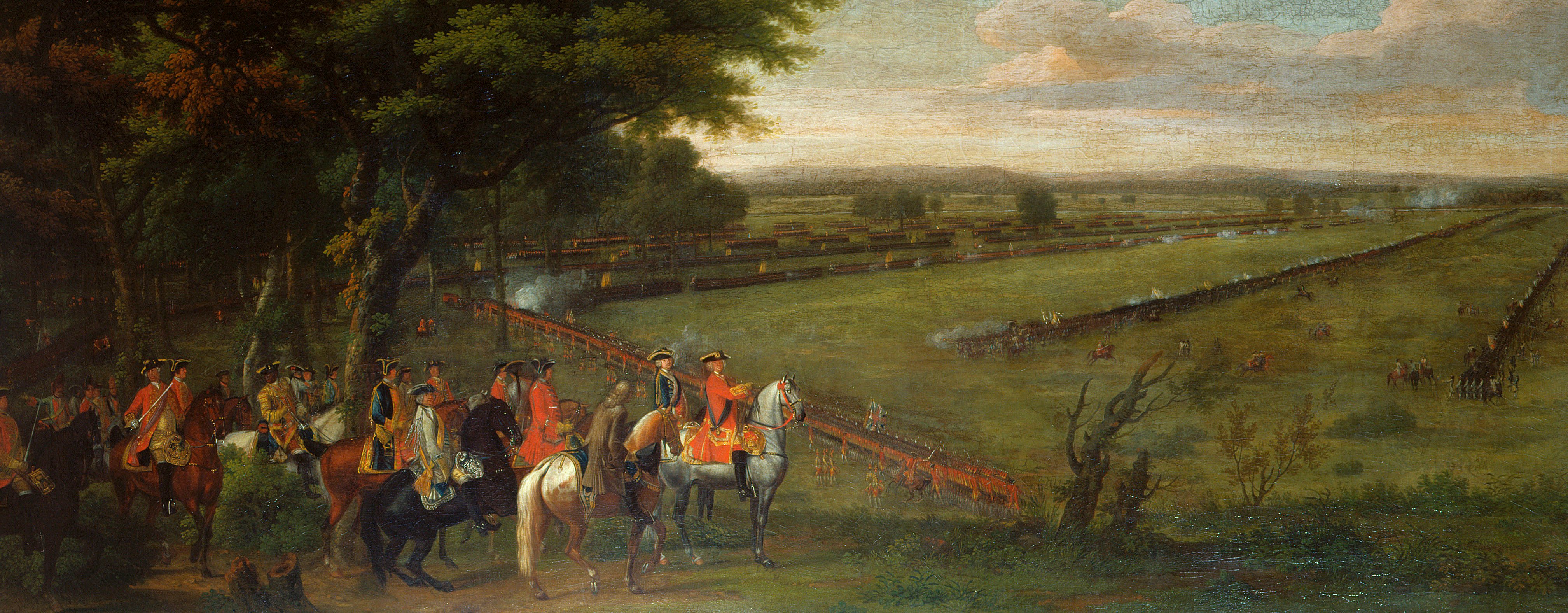
War of the Austrian Succession (1740-8)
Includes much of the mapping collected by William Augustus, Duke of Cumberland, as Captain General of the British army
Sketch of encampment at Oisterwijk, 1747 (Oisterwijk, North Brabant, Netherlands) 51°34'45"N 05°11'20"E
c.1747Pencil on paper; some pricking through | Scale: 1:31,600 approx. | RCIN 730184
The attribution to Schultz is made on stylistic grounds. The positions of the lines of encamped troops are indicated by half rectangles, some are annotated ‘cav’ for cavalry. It is possible that the letters ‘f’ and ‘p’ which are written in several places are annotations on land use: ‘f’ may stand for ‘Feldt’ or field, ‘fahl’ or fallow, ‘flach’, plain or level, or ‘Futterpflanzen’, forage crops, while ‘p’ may represent ‘pflügbar’ or arable. In French, ‘p’ may represent prairie, or meadow, while ‘f’ may stand for ‘foin’ or hay. The selection of German as the likely language is based on the letter ‘f’ which appears to be written in Deutsche schrift, which was used by Schultz. A detailed plan of the camp by Daniel Paterson is at RCIN 730180.e; it does not assist in interpreting the meaning of the letters.
A short description of Oisterwijk appears in the journal of The Hon. Charles Colville for 11 October 1747 [i.e. 22 October New Style]: 'Oosterwyck is a pretty long village: the most remarkable thing here is a lime tree which grows in the street; the trunk of it is not above fifteen feet in circumference, and about six feet and a half high, but the branches, which by art shoot out horizontal, are of a size quite unproportioned to the bigness of the trunk, being supported by posts to prevent their falling to the ground; they terminate in a circular form, the diametre of which makes about 120 feet, and had a very pretty appearance. Trees of this form are common enough in the country but this is allowed to be the largest of the whole.' Schultz appears to have drawn a large tree at the north-eastern end of the village which may have been the tree described by Colville. It is not shown on RCIN 730180.e.
For further reading, see:
'Military Memoirs of Lieut.-General The Hon. Charles Colville', Part III, Section IV. Journal of the Society for Army Historical Research, vol.28, 1950, p.10.
Condition: six fold lines; unevenly trimmed.
? George Augustus Schultz (active 1734-49) (surveyor and draughtsman)
Subject(s)
Army-GBWatermark: Horn in crowned shield, a bell with small circle and N VORSTER below
Mark, stamped: 714
Condition: six fold lines; unevenly trimmed
Scale: 1:31,600 approx. Scale bar: [63 mm =] 20 unnamed units.
23.7 x 25.7 cm (image and sheet)
Manuscript title:
No title
Annotations:
George III heading: Encampment at Oosterwyck 22 Oct.r 1747.
Other annotations: (Recto) none. (Verso) [left of centre, black pencil, in Schultz's hand?:] Oosterwyck.
George III catalogue entry:
Encampment A drawn Sketch of the Encampment of the British Troops at Oosterwyck, 22.d Oct.r 1747. [The same entry appears under the heading Oosterwyck.]
Subject(s)
Oisterwijk, North Brabant, Netherlands (51°34'45"N 05°11'20"E)
Bibliographic reference(s)
C. Colville, ‘Military memoirs of Lieut.-General The Hon, Charles Colville, Part III, Section IV.’ Journal for the Society for Army Historical Research, vol.28, 1950
Page revisions
25 May 2024
Current version






